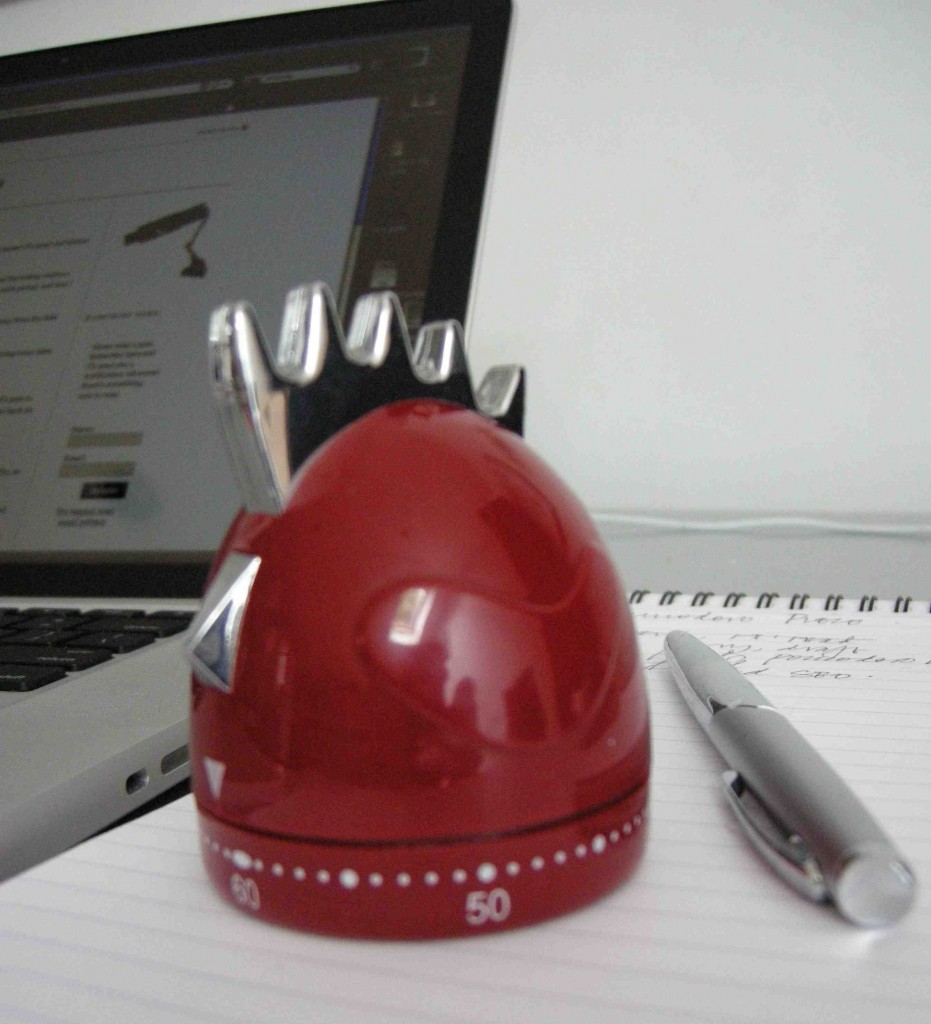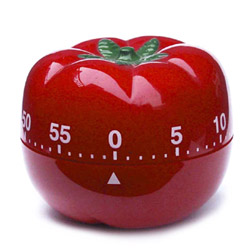
My red hen, my favorite pen, and the side of my notebook
When I write these blog posts, most of the time I do it to the sound of a small red kitchen timer, shaped like a chicken.
Cranking the timer is a signal that the work is going to begin, and the ticking creates a reassuring sound barrier – it tells me that I can put everything else aside and just focus on what I’m doing.
I set the timer for 25 minutes, and when it rings, I get up and walk away from the desk for a five-minute break.
Sometimes I spend five minutes on the Sisyphean task of clearing the dining room table. Sometimes I unload the dishwasher or put in a load of laundry.
On other breaks I might do a spinal stretch at the kitchen counter, or a sequence of child’s pose to downward dog to forward bend or any other five-minute yoga practice that feels right . Sometimes I lie on the floor and roll my upper back on tennis balls.
Then I’m back, time permitting, for my next 25 minutes with the chicken.
This is my modest practice of the Pomodoro Technique, invented by Francesco Cirillo, an Italian computer programmer.
When he was a student, in the late 1980s, Cirillo became overwhelmed by deadlines and looming exams. In a stroke of genius, he realized that his enemy was not time, but distraction. He decided to challenge himself by setting a timer and concentrating for just 10 minutes.
The timer at hand happened to be a kitchen timer in the shape of a red tomato, hence the Pomodoro Technique.
Over the next few years he refined and developed the technique, and wrote an instruction manual for it, which you can download for free from his website.
Ideally, Pomodoros are done in sets of four with a longer break, up to half an hour, when the fourth set is finished. And there’s a system for estimating and keeping track of how many Pomodoros your task will take.
Cirillo now has a company that teaches how to quickly create effective software, as well as an educational branch that focuses on teaching the Pomodoro Technique.
Although it comes out of a software background, I’d argue that there’s a lot for a curious yogi to learn from Cirillo’s technique. Here are four good places to start:
1. The Pomodoro Technique is good for your body. Any sedentary work needs to be regularly broken up with movement. When I’m focused on writing, I forget everything I know about good posture. The two most surprising things I notice when the chicken rings are first, how hard it is to get up and tear myself away, and second, how bad my posture becomes when I’m not paying attention to it. Taking a break after 25 minutes means my desk posture doesn’t have as much of a chance to settle in.
2. It promotes concentration, which is the sixth of the eight limbs of yoga. For almost all of us, almost all of the time, the biggest problem we face is keeping our minds engaged in the task at hand, whether it’s studying for an exam, focusing on our alignment in triangle pose or watching our breath in sitting meditation.

Pomodoro means tomato in Italian
Dharana, or concentration, is the first of the three internal limbs, and like all the other limbs of yoga, it’s a practice. Whether it’s focusing on an object in meditation, or focusing on a task as you complete a Pomodoro, the more you practice concentration, the better you get.
3. It gets you in the habit of shifting your mental state. A large part of integrating yoga into daily life is to understand the yogic view of reality and to continually make the distinction between pure awareness and the pressing, urgent issues that are tugging at your pant legs.
Every 25 minutes, the timer tells you to come up for air and consciously change your mental state. That provides you with a call to consciousness as many times as there are Pomodoros in your day.
4. Two of the rules of the Pomodoro Technique are also among the most important unwritten rules of yoga practice:
• Results Are Achieved Pomodoro after Pomodoro, and
• The Next Pomodoro Will Go Better
Results are achieved practice after practice, and when you keep at it, day by day, the next practice will go better too.





Comments on this entry are closed.
Thank you for this. I have a friend who used to set a timer for 10 minutes and then get her family to do 10 minutes of house cleaning together. I like using a timer for my restorative poses so that I stay in them long enough to be restored. My restless mind always wants me to move on more quickly than I need to.
Hi Claire,
I’m a fan of the 10-minute tidy myself. Most often I use the stove timer, and clean the kitchen for 10 minutes after supper. Whenever I manage that, I’m so grateful the next morning.
There is something wonderful about the way setting a timer calms the mind. For me it shuts off the section that’s always asking: “how long has it been?” and “are we done yet?”
Eve,
Really enjoyed this post. I have long loved timing things – burst of work I need to get done, tea steeping, pranayama. The idea of the chicken makes it even more fun. I have just found mine and can’t wait to crank ‘er up!
Anita
Hi Anita,
Great to hear from you!
There’s something wonderful about the small gadgets that help us out with our lives, especially when they are as unassuming as a kitchen timer. I’ve become very fond of my chicken, maybe even a little dependent on her steady ticking. I hope she has a long life helping me be productive.
What a wonderful idea! I am hoping to experience success with this technique and have been looking for an inspiring timer of my own. However, I am having trouble finding one. Can you please tell me where you purchased yours?
Thank you!
Hi Leslie:
I just walked up the street to my neighborhood kitchen store, and there it was. It cost something like $4.95, if I remember correctly.
Good luck with your search.
Fabulous approach! Thank you for sharing this technique. I look forward to exploring it with my own work.
First of all, let me say I look forward to all your posts but this one is so brilliant. I know I should respond more often to let you know I never miss reading your blogs. I do love this “timer” idea!
Intriguing proposition that I must try.
Like Jenn, I am an expert multitasker, especially on the computer. Despite high-speed Internet access, I find myself impatient when webpages take more than a second to load. So I switch to another work project, or check email, or check Google News, or sneak a peek at my blog stats! Sometimes, I actually enjoy the energy of “juggling,” and feel like it spurs my brain to a higher rev. But often I think it’s somehow reducing my concentration.
So, this method might encourage some laser focus. I also like the “deadline” pressure, which always increases my efficiency.
As for equipment: I could use the kitchen timer that I’ve used for meditation/asana (it’s digital and not NEARLY as cute as your chicken).
WOW, this is inspiring. For someone who is terribly proficient at multi-tasking (a blessing and a blessed curse) I can see how actually setting up a system like this could help me in so many areas of my life….at work, where I am constantly pulled from one email to another, one task to another, one request to another….at home where I am pulled between the household obligations and the urge to lay limp and disengaged on the couch and veg. To set a timer (even if that timer is the few minutes of commercials interspersed throughout my Grey’s episode) to stretch, to breathe, to focus, to dog my way downward, feels like a very possible way to get things done. Thank you for a introducing me to this I-can-perceive-fantastico-technique!
Jenn